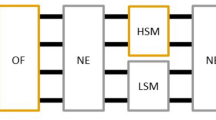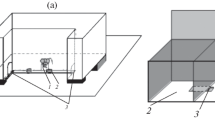Abstract
Mus spretus is extensively used in interspecific mouse backcross analyses employed to generate genetic linkage maps. However, little is known about its behavior and neuroanatomy, phenotypes for which large interstrain differences have been observed in Mus musculus domesticus. Behavioral and hippocampai neuroanatomical variables were measured in adult male mice from the inbred strains C57BL/6J (Mus musculus domesticus) and SEG (Mus spretus). Clear differences were found for behavioral responses to novelty in an open field, SEG being much less active than C57BL/6J. Morphometrical analysis of hippocampai terminal fields, visualized with Timm's stain, revealed strain differences only for the size of the intra- and infrapyramidal mossy fiber terminal fields, which were about 3× larger in C57BL/6J than in SEG. In addition, absolute left-right differences were larger in SEG for the stratum radiatum and stratum oriens. In spite of these behavioral and neuroanatomical differences, the phenotypical scores obtained for SEG do not exceed the range observed for Mus musculus domesticus inbred strains.
Similar content being viewed by others
REFERENCES
Barber, R. P., Vaughn, J. E., Witner, R. E., and Wimer, C. C. (1974). Genetically-associated variations in the distribution of dentate granule cell synapses upon the pyramidal cell dendrites in mouse hippocampus. J. Comp. Neurol.156:417-434.
Bernasconi-Guastalla, S., Wolfer, D. P., and Lipp, H.-P. (1994). Hippocampal mossy fibers and swimming navigation in mice: Correlations with size and left-right asymmetries. Hippocampus4:53-64.
Crusio, W. E. (1995). Natural selection on hippocampal circuitry underlying exploratory behaviour in mice: Quantitative-genetic analysis. In Alleva, E., Fasolo, A., Lipp, H.-P., Nadel, L., and Ricceri, L. (eds.). Behavioural Brain Research in Naturalistic and Semi-Naturalistic Settings, Kluwer, Dordrecht, The Netherlands, pp. 323-342.
Crusio, W. E., and Schwegler, H. (1987). Hippocampal mossy fiber distribution covaries with open-field habituation in the mouse. Behav. Brain Res.26:153-158.
Crusio, W. E., and van Abeelen, J. H. F. (1986). The genetic architecture of behavioural responses to novelty in mice. Heredity56:55-63.
Crusio, W. E., Genthner-Grimm, G., and Schwegler, H. (1986). A quantitative-genetic analysis of tiippocampal variation in the mouse. J. Neuroge.net.3:203-214.
Crusio, W. E., Schwegler, H., and Lipp, H.-P. (1987). Radialmaze performance and structural variation of the hippocampus in mice: A correlation with mossy fibre distribution. Brain Res.425:182-185.
Crusio, W. E., Schwegler, H., and van Abeelen, J. H. F. (1989a). Behavioral responses to novelty and structural variation in the hippocampus in mice. I. Quantitative-genetic analysis of behavior in the open-field. Behav. Brain Res. 32:75-80.
Crusio, W. E, Schwegler, H., and van Abeelen, J. H. F. (1989b). Behavioral responses to novelty and structural variation in the hippocampus in mice. II. Multivariate genetic analysis. Behav. Brain Res.32:81-88.
Crusio, W. E., Schwegler, H., and van Abeelen, J. H. F. (1991). Behavioural and neuroanatomical divergence between two sublines of C57BL/6J inbred mice. Behav. Brain Res. 42:93-97.
Crusio, W. E., Schwegler, H., and Ernst, I. (1993). Covariations between hippocampal mossy fibres and working and reference memory in spatial and non-spatial radial maze tasks in mice. Ear. J. Neurosci.5:1413-1420.
Danscher, G., and Zimmer, 1. (1978). An improved Timm sulphide silver method for light and electron microscopic localization of heavy metals in biological tissues. Histochetnistry55:27-40.
Dietrich, W., Katz, H., Lincoln, S, E., Shin, H.-S., Friedman, J., Dracopoli, N. C,, and Lander, E. S. (1992). A genetic map of the mouse suitable for typing intraspecific crosses. Genetics131:423-447.
Guenet, J. L., Nagamine, C., Simon-Chazottes, D., Montagutelli, X., and Bonhomme, F. (1990). Hst-3: An X-linkcd hybrid sterility gene. Genet. Res.56:163-165.
Guillot, P.-V., Roubertoux, P. L., and Crusio, W. E. (1994). Hippocampal mossy fiber distributions and intermale aggression in seven inbred mouse strains. Brain Res.660: 167-169.
Hausheer-Zarmakupi, Z., Wolfer, D. P., Leisinger-Trigona, M.-C., and Lipp, H.-P. (1996). Selective breeding for extremes in open-field activity of mice entails a differentiation of hippocampal mossy fibers. Behav. Genet.26:167-176.
Hensbroek, R. A., Sluyter, F., Guillot, P.-V., van Oortmerssen, G. A,, and Crusio, W. E. (1995). Y chromosomal effects on hippocampal mossy fiber distributions in mice selected for aggression. Brain Res.682:203-206.
Justice, M. J., Siracusa, L. D., Gilbert, D. J., Heisterkamp, N., Groffen, J., Chada, K,, Silan, C. M., Copeland, N. G., and Jenkins, N. A. (1990). A genetic linkage map of mouse chromosome 10: Localization of eighteen molecular markers using a single interspecific backcross. Genetics125:855-866.
Lipp, H.-P., and Schwegler, H. (1982). Hippocampal mossy fibers and avoidance learning. In Lieblich I. (ed.), Genetics of the Brain, Elsevier Biomedical, Amsterdam, pp. 325-364.
Lipp, H.-P., and Wolfer, D. P. (1995). New paths towards old dreams: Microphrenology or the study of intact brains in intact worlds. In Alleva, E., Fasolo, A., Lipp, H.-P., Nadel, L., and Ricceri, L. (eds.), Behavioural Brain Research in Naturalistic and Semi-Naturalistic Settings, Kluwer, Dordrecht, The Netherlands, pp. 3-36.
Lipp, H.-P., Collins, R. L., Hausheer-Zarmakupi, Z., Leisinger-Trigona, M.-C., Crusio, W. E., Nosten-Bertrand, M., Signore, P., Schwegler, H., and Wolfer, D. P. (1996). Paw preference and intra/infrapyramidal mossy fibers in the hippocampus of the mouse. Behav. Genet.26:379-390.
Matsuda, Y. M., Hirobe, T., and Chapman, V. M. (1991). Genetic basis of X-Y chromosome dissociation and male sterility in interspecific hybrids, Proc. Nail. Acad. Sci. USA88:4850-4854.
Schopke, R., Wolfer, D. P., Lipp, H.-P., and Leisinger-Trigona, M.-C. (1991). Swimming navigation and structural variations of the infrapyramidal mossy fibers in the hippocampus of the mouse. Hippocampus1:315-328.
Schwegler, H., and Lipp, H.-P. (1983). Hereditary covariations of neural circuitry and behavior: Correlation between the proportions of the hippocampal synoptic fields in the region inferior and two way avoidance in mice and rats. Behav. Brain Res.7:1-38.
Schwegler, H., Lipp, H.-P., van der Loos, H., and Buselmaier, W. (1981). Individual hippocampal mossy fiber distribution in mice correlates with two-way avoidance performance. Science214:817-819.
Schwegler, H., Lipp, H.-P., and Crusio, W. E. (1988). NZB mouse: Hippocampal mossy fiber patterns and behavioral profiles of young and older animals. Drug Dev. Res.15: 297-305.
Schwegler, H., Crusio, W. E., and Brust, I. (1990), Hippocampal mossy fibers and radial-maze learning in the mouse: A correlation with spatial working memory but not with non-spatial reference memory. Neuroscience34:293-298.
Siegel, S. (1956). Nonparametric Statistics for the Behavioral Sciences, McGraw-Hill, New York.
Slomianka, L., and West, M. J. (1987). Asymmetry in the hippocampal region specific for one of two closely related species of wild mice. Brain Res.436:69-75.
Author information
Authors and Affiliations
Rights and permissions
About this article
Cite this article
Laghmouch, A., Bertholet, JY. & Crusio, W.E. Hippocampal Morphology and Open-Field Behavior in Mus musculus domesticus and Mus spretus Inbred Mice. Behav Genet 27, 67–73 (1997). https://doi.org/10.1023/A:1025667426222
Issue Date:
DOI: https://doi.org/10.1023/A:1025667426222




